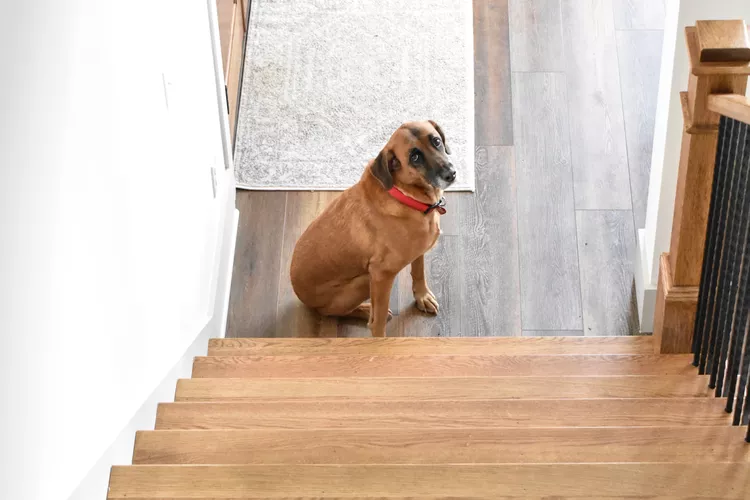
Is your dog afraid of the stairs? Some dogs are afraid of going up and down stairs. This is a fairly common fear or phobia, especially in young dogs who may not have encountered them while they were puppies. Fortunately, you can help your dog get over this fear and go up and down the stairs with confidence. Here's what you need to know if your dog has a fear of the stairs.
Before you begin searching for behavioral issues that may cause a dog's fear of stairs, talk to your veterinarian. Your dog's fear may stem from a physical problem. He may not want to go up and down the stairs because it causes him pain (in cases of arthritis or an injury). Have your veterinarian rule out a medical condition before you start any training.
Many dogs who are afraid of stairs develop the fear because of a lack of early exposure. If you live in a single story home, it's possible that your dog won't see stairs until a little later in life. Some dog owners may have discouraged their puppies from going on the stairs to keep them contained to a limited area.
In some instances, a dog may develop a fear of stairs from a traumatic experience. For example, a dog who falls down the stairs may be left with a phobia of climbing stairs.
Most of the time, a dog's fear of stairs is easy to overcome. The following tips can help you navigate the process:
Remember to be patient with your dog. Depending on its level of fear, it may take some time for it to get comfortable with the stairs. Work in short, upbeat training sessions. If your dog seems overwhelmed, frustrated, bored, or stressed, it's time to end the session. Always try to end on a positive note. If you find that your dog's phobia is too intense to overcome, it's a good idea to seek help from a dog trainer or behaviorist. You can ask your vet for recommendations to help you find the right professional.
Edited by Jenna Stregowski, RVT

75 Unisex Cat Names
Our gender neutral cat names perfect for your feline friend, with a diverse selection of fun and inclusive options to fit your pet's disposition.
Why Does My Cat Stink?
Is your cat stinky? Find out about the causes of bad odors in cats and when it is something to be concerned about. Learn how to help your stinky cat.
Signs of Rabies in Cats
Rabies is a fatal and contagious virus that can affect cats. Learn about the signs of rabies in cats and what to do about them.
Can Cats Eat Dog Food?
Can cats eat dog food? In small amounts, it's unlikely to be a problem, but long-term feeding of dog food to cats can cause health issues and malnutrition.
Exploring the Different Types of Pet-Friendly Beaches
Are you looking for pet-friendly beaches? Learn about the different types of pet-friendly beaches, their locations, and tips for visiting them with your pet.
Pulled Muscles in Dogs
A pulled muscle is one of the most common injuries seen in dogs. What can you do if your dog pulls a muscle and how can you prevent it?
Fibrosarcoma in Cats
Fibrosarcomas are potentially fatal soft tissue tumors that can occur in cats. Learn the causes, treatment, and prevention.
Alopecia in Dogs
Alopecia leads to hair loss and bald spots in dogs. Some breeds may be more at risk. Learn common causes, treatment, and prevention of dog alopecia.
Is Acetaminophen Safe for Dogs?
Acetaminophen is used by humans for pain and fever relief, but is it safe for dogs? Here's what you need to know before giving your dog acetaminophen.
Can Dogs Eat Almonds? Understanding the Risks and Guidelines
Can dogs eat almonds? While a couple likely won't hurt, it's best to avoid feeding your dog this nut. Learn the risks here.
Keeshond: Dog Breed Characteristics & Care
Learn about the keeshond dog, also known as the Dutch Barge Dog. This fluffy spitz breed was bred to guard, but also makes a friendly companion.
Is Rosemary Safe for Dogs?
Rosemary is used both for cooking and as a supplement with many reported health benefits in people, so you may be wondering if it is safe to give to your dog. Rosemary is considered non-toxic for dogs but with some caveats.
7 Hybrid Cats Breeds
Hybrid cat breeds can make appealing pets since they look more exotic than domestic house cats, but they aren't for everyone.
The Best White Cat Breeds to Keep as Pets
Several breeds can result in white cats with long or short hair. Find out the pros and cons of these white cat breeds.
11 Cute Pictures of Ragdoll Cats
Ragdoll cats are known for their beautiful coats and bright, blue eyes. Learn all about the breed, and check out some cute pictures here.
7 Reasons Why Your Cat Eats Paper, and How to Stop It
Is your cat eating paper? Learn why your cat is doing this, and find out how to put a stop to it.
Feist: Dog Breed Characteristics & Care
Feists are small, short-haired dogs developed to hunt squirrels and catch vermin. These high-energy, affectionate pooches make great companion animals.
Dogue de Bordeaux (French Mastiff): Dog Breed Characteristics & Care
Learn about the Dogue de Bordeaux, also called the French mastiff. Although large and muscular, they’re known for their calm and gentle personality.
How to Stop Your Dog From Fearing Men
Many dogs have a phobia of men. Learn how to help your dog overcome its fear through desensitization and training while keeping everyone safe.
Why Dogs Eat Poop and How to Stop Them
Is your dog eating poop? Some dogs do this because of stress or illness. Learn how to prevent stool eating, or coprophagia, in dogs.